M. Essiari1, A. Mouhajir1, S. Mouhsine El Hayani1, R. El Kahkahi2, A. Lemrhari3, R. Errakhi2, R. Zouhair1, H. Chimi3, S. Bachir1
1Laboratory of Plant Biotechnology and Molecular Biology, Department of Biology, Faculty of Science, University Moulay Ismail, Meknes, Morocco
2Laboratory of Molecular Biology, Centre for Innovation and Transfer Moulay Ismail University Meknes, Morocco
3Department of Food Science and Nutritional, Agricultural and Veterinary Institute Hassan II, Rabat, Morocco
Correspondence to: R. El Kahkahi, Laboratory of Molecular Biology, Centre for Innovation and Transfer Moulay Ismail University Meknes, Morocco.
| Email: |  |
Copyright © 2015 Scientific & Academic Publishing. All Rights Reserved.
Abstract
Background: Evaluation of some physic-chemical quality parameters virgin oils were discussed in four varieties of olive Moroccan (Moroccan Picholine, Arbequina, and Haouzia Menara) during storage. Method: The evaluation of these quality parameters is based on the development of three key quality indices, the acid (Ia), the peroxide value (Ip) and E232 and E270 specific extinctions. Result: The oxidative stability of olive oils is studied in dependence on the variety and growing area. The results show that during a year of follow-up, all oils tested Moroccan varieties contain indications of acidity and peroxides indices follow the standards set by the IOC. The variety Arbequina by cons has a peroxide value that begins to reach 20 Meq (O2) / kg after a year of storage. Similarly, the specific extinction at 232 nm and 270 nm shows significant differences between varieties and growing areas. Moroccan oil varieties (Moroccan Picholine, Haouzia and Menara), however, presented the best quality standards. Thus, these oils have shown the acid, E232 and E270, and the index of the lowest peroxide relative to the oil of the Spanish variety (Arbequina). Point of view area, all results show that the oils produced at area 1 are stable enough that the oils produced in the area 2. Conclusions: All the results obtained to suggest that the quality criteria of the four varieties of oils studied show that Sais region appears to be a favorable region for the production of high-quality olive oil. Nevertheless, the quality of oil in terms of wealth in antioxidants and oxidative stability depends on the varietal profile and the growing area. Indeed, the Spanish variety (Arbequina) recently appreciated by many growers due to its early entry into production and oil yield per hectare (high density planting), still remains an unstable manifold, given that this oxidative stability and low levels of natural antioxidants compared to Moroccan varieties.
Keywords:
Arbequina, Haouzia, Acid value, Peroxide value, Menara and Moroccan Picholine
Cite this paper: M. Essiari, A. Mouhajir, S. Mouhsine El Hayani, R. El Kahkahi, A. Lemrhari, R. Errakhi, R. Zouhair, H. Chimi, S. Bachir, Evaluation of the Physic-chemical Quality Parameters of Virgin Olive Oils from Four Varieties Moroccan (Moroccan Picholine, Arbequina, Haouzia and Menara) during Storage, International Journal of Food Science and Nutrition Engineering, Vol. 5 No. 3, 2015, pp. 154-162. doi: 10.5923/j.food.20150503.07.
1. Introduction
The olive oil consumption is expected to increase dramatically, thanks in particular to the positive image associated with its content of monounsaturated fatty acids and natural antioxidants [8]. Olive oil is characterized by its high oxidative stability due to its high content of unsaturated fatty acids (72% monounsaturated and 14% polyunsaturated) in the Free State and / or esterified triglyceride [13].Improving the quality of olive oil is dictated by the imperatives of national and international market. It depends on the choice of olive varieties that produce oils with organoleptic and physicochemical defying all qualitative restrictions. Strengthening our olive oil production in Morocco, both qualitatively and quantitatively, especially regarding the production of olive oil and its stability during storage requires the choice of performing varieties [15].During storage of oils, qualitative changes are generally caused by chemical reactions whose oxidation [14]. These changes differ from variety to another and / or culture area to another. The autoxidation is the major cause of deterioration of oils during storage. It depends on several factors such as the initial composition of the oil, the presence and minor compounds content antioxidant activity (minerals, tocopherols, carotenoids, chlorophylls) and storage conditions [6].The alteration of fats depends on their chemical structure. Indeed, firstly, triesters can hydrolyze and give partial glycerides and free fatty acids [21], and on the other hand, the unsaturated chains can react with the oxygen to form oxidation products responsible for rancidity of fats. These two phenomena are the cause of the two main forms of alteration of food fats (acidification and oxidation) [14].The purpose of this article is to study the effect of storage in the dark at room temperature on the stability of the physicochemical properties of three Moroccan varieties of olive oils (Moroccan Picholine, Haouzia and Menara) and a Spanish variety (Arbequina) recently appreciated by growers for its early entry into production and oil yield per hectare. The evaluation of these quality parameters is based on the development of three key quality indices, the acid (Ia), the peroxide value (Ip) and E232 and E270 specific extinctions.
2. Materials and Methods
2.1. Plant Material and Growing Area
The study was conducted during the crop years 2010/11, 2011/12 and 2012/13 in two different growing areas (area 1 = Ain Taoujdate - El Hajeb and area 2 = Ait-Ouallal-Meknes). Both regions are selected on the basis of quality, regularity of oils obtained especially from their diverse and important olive-growing heritage. The oils used are derived from the Moroccan Picholine (V1), the Arbequina (V2), Haouzia (V3) and Menara (V4); they were obtained by a continuous two-phase system and collected in modern mills.
2.2. Analysis of the Olive Oil
The oils V1, V2, V3 and V4 of each culture area (fruits harvested at the optimum stage) were obtained from their bottles. To study the effect of storage on the oxidative stability of the oils, the samples were stored at room temperature and in the dark for one year. Evaluation of physic-chemical quality parameters of virgin olive oil (acid value, peroxide value, E232 and E270 specific extinctions) were carried out for periods of 30 days apart.The analyse of the samples were performed in oil analysis laboratory of the company preserve the Meknes (LCM).
2.3. Free Acidity
The acidity is expressed as a percentage of oleic acid from olive oil. This is used as a simple and effective way for qualitative assessment and classification by commercial category of olive oil (ISO 660 reference 2009). The principle of the method consists of the dissolution of a known amount of fat in hot ethanol, then titration of free fatty acids with an aqueous solution of potassium hydroxide KOH required to neutralize the free fatty acids present in fat 1g.
2.4. Peroxide Value
The amount of peroxide present in a sample is the number of milliequivalents of active oxygen per kilogram (meq O2/kg of olive oil) of product and oxidant potassium with iodine release in the conditions of the ISO 3960: 2007. The principle of this method is the treatment of a test sample in solution in a mixture of acetic acid and iso-octane, and then a potassium iodide solution. Visually determining the liberated iodine with peroxides using a starch indicator and a sodium thio-sulphate solution.
2.5. Ultraviolet Absorption Indices
The determination of specific extinction coefficients at 232 nm (E232); 270 nm (E270) and Delta K is based on ISO method 3656. The principle of this method is the study by spectrometry in a specified field of wavelength in the ultraviolet absorbance of a sample solution. Calculating the absorbance is at a concentration of 1 g per 100 ml in a vessel of 10 mm thickness.
2.6. Statistical Analysis
Statistical analysis of the measured data was performed through the descriptive statistics, using the Statistical software version 10.0. The goal is, to summarize, all the information and results as standardized curves to enable ease of interpretation and visualization of large gaps between different qualitative and quantitative variables studied.
3. Results and Discussion
Comparative study of the stability of the olive oil of the four varieties studied during storageEvolution of the acidity index during storageThe acidity is expressed as a percentage of oleic acid. It provides information on the hydrolysis of oil weathering3. The evolution of the acidity index values during three seasons (2010 to 2013) and in two areas of different cultures is presented in Figures (1-3).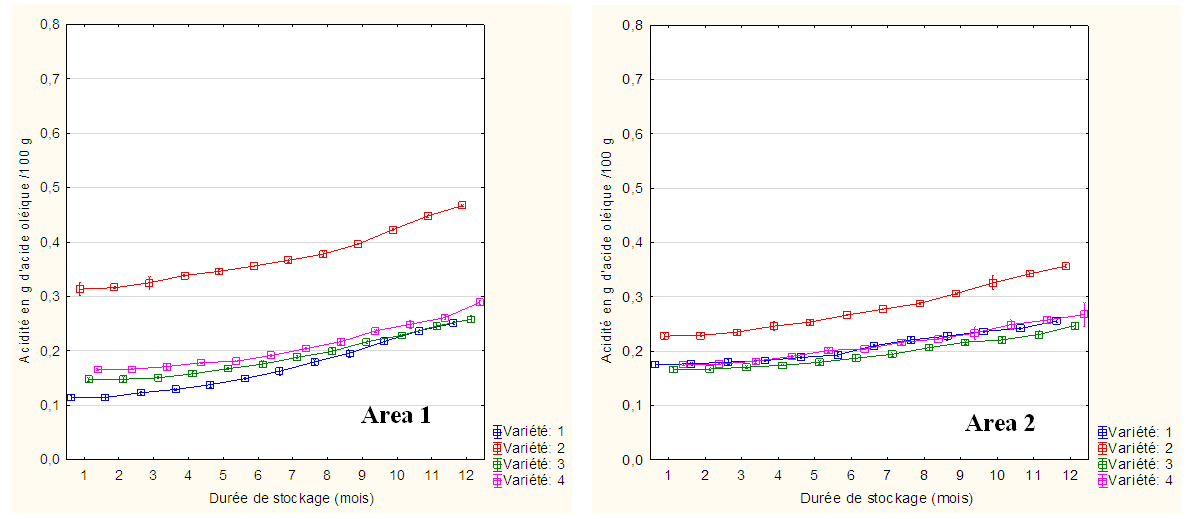 | Figure 1. Evolution of the acidity of olive oil (2010/2011) |
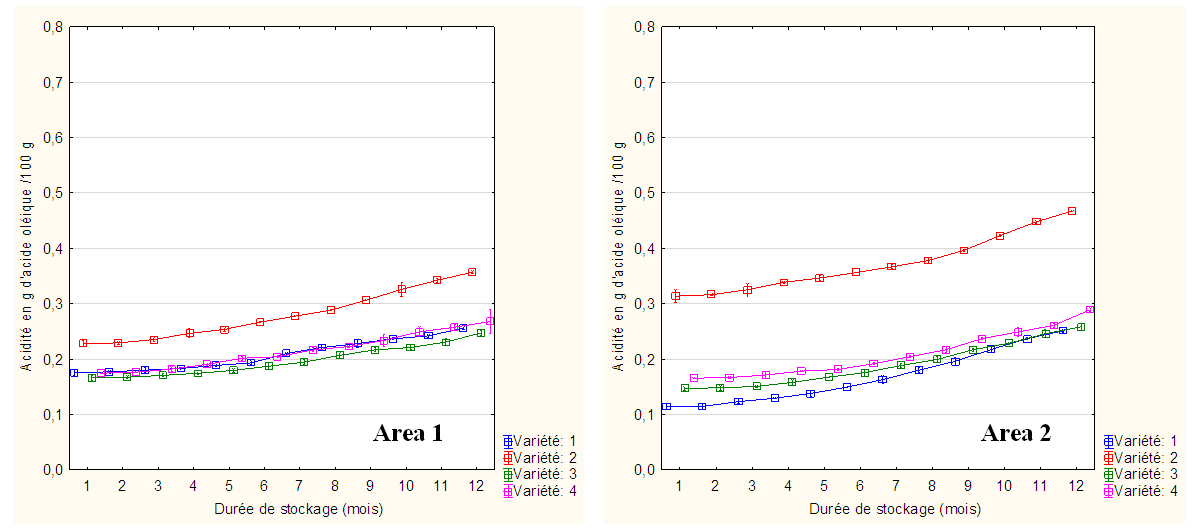 | Figure 2. Evolution of the acidity of olive oil (2011/2012) |
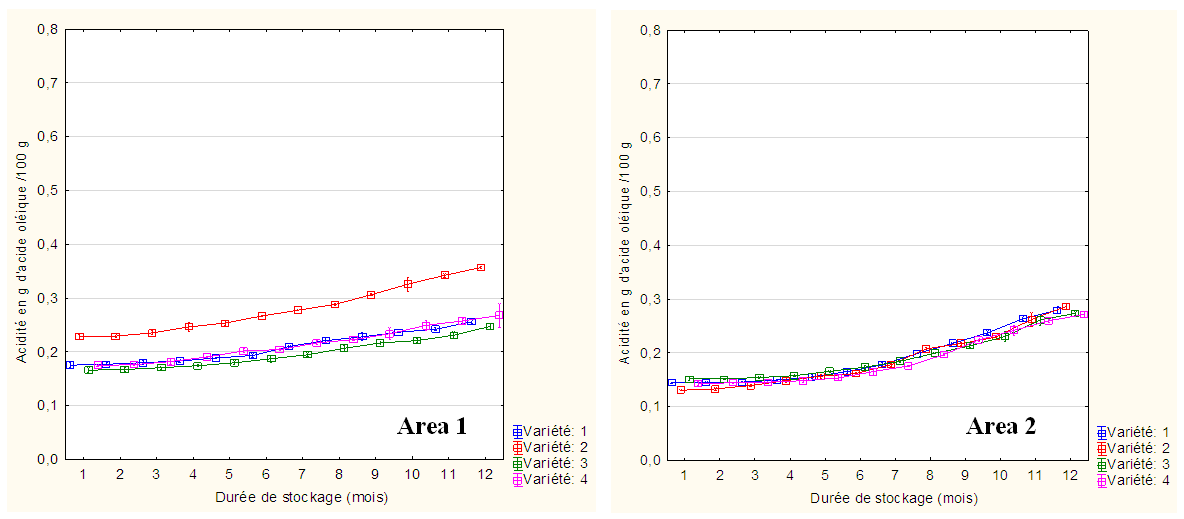 | Figure 3. Evolution of the acidity of olive oil (2012/2013) |
The evolution of the acidity of the four varieties oils in two areas of crops (area 1 = Ain Taoujdate - El Hajeb and area 2 = Ait-Ouallal Meknes) during the 2010/2011 campaign shows that the acidity of the four varieties undergone changes throughout the storage period (Figure 1). This trend differs from one variety to the next and from one zone to another. This rate is felt in variety Arbequina oil. Indeed, by growing area, the acidity of the oils of the three varieties Moroccan, Moroccan Picholine, and Menara Haouzia suffered an increase, respectively, for area 1, from 0.31 to 0.37%, 0.30 0.38% and 0.30 to 0.37%, while that of the Arbequina oil, the increase passed from 0.41 to 0.61%. For area 2, this acidity has also been an increase, but remains below that of the acidity of the oils of the four varieties in area 1. The acidity increased from 0.23 to 0.36% for the Moroccan Picholine, about 0.25 to 0.36% for Haouzia and 0.24 to 0.37% for Menara, while that of the Arbequina oil acidity has been increased from 0.37 to 0, 67%. However, the oils of the four varieties grown in zone 2 are less stable than those grown in area 1. The oils of the four varieties Morocco (Moroccan Picholine, Haouzia and Menara), however, presented the best quality standards. After 12 months of storage in the dark at ambient conditions, these four varieties have not lost oil labeling "extra virgin".The same trend was observed (Figure 2) for the four oils stored in the 2011/12 campaign. There is still a rate higher acidity in the oil from Arbequina. For Moroccan varieties (Moroccan Picholine, Haouzia and Menara) the difference in acidity between them is minimal. In both areas of culture, the difference in acidity is low for Moroccan varieties. This difference is clearly visible to the oil of the Arbequina variety in both areas. From a qualitative point of view, the four studied oils have not lost oil labeling "extra virgin" after 12 months of storage in the dark at ambient conditions.For samples stored during the 2012/2013 campaign, Figure 3 showed the same trends as those recorded during other previous campaigns, but with much less low proportions. These results are also the same as those reported by other authors [19, 20, 10, 7]. Acidity of the rate varies from 0.19% to 0.24% (area 1) and from 0.15% to 0.27% (area 2) for oil Picholine Moroccan, and from 0.21 to 0.35% (area 1) and 0.20% to 0.25% (area 2) for the oil of Arbequina. Other oil Moroccan (Haouzia and Menara) has almost the same value of acidity; they increased from 0.15% to 0.25% in the two growing areas. At the end of the year we see that the acidity of the oil from Arbequina is more pronounced in the oil produced in area 1, it reaches a percentage of 0.35%. The acidity of the other oils of the same area (Moroccan Picholine Haouzia and Menara) remains at around 0.26%.It should be noted that during this campaign, in both areas of culture, the acidity of the four studied oils does not reach the upper limit of 0.8% for labeling authorized "extra virgin" after 12 months of storage in the dark ambient conditions.Evolution of the peroxide value during storageIndependently storage conditions, the index of the oil of peroxide increases with storage time. This index is a qualitative criterion, helpful satisfactory sensitivity to appreciate the early stages of oxidative deterioration [3, 16]. It is used to estimate the expiry date of an oil and consumer acceptance.During the 2010/2011, all the oils of the four varieties have been an evolution of the peroxide value (hydroperoxides) during the period of storage in the dark at ambient conditions (Figure 4). This trend is more intense for the Arbequina oil, which recorded values ranging from 7.05 to 19.18 Meq (O2)/kg in area 1 and 5.05 to 18.54 Meq (O2)/kg area 2 after 12 months of storage. Indeed, the largest increase in the peroxide value variety Arbequina oil is explained by the low stability of this oil in relation to the stability of the other oils tested. These results are consistent with those of [11, 10, 7], during the storage of studies of the Arbequina oil. For oils of the three varieties Moroccan (Moroccan Picholine, Haouzia and Menara), they have been less intense development compared to that of the Arbequina respectively in the two areas ranging from 6.35 and 6.88 Meq (O2)/kg; 7.32 and 5.94 Meq (O2)/kg; 6.4 and 6.37 Meq (O2)/kg to 14.68 and 15.75 Meq (O2)/kg; 15.52 and 14.14 Meq (O2)/kg; 13.12 and 13.28 Meq (O2)/kg) without losing their oil and extra virgin labeling after 12 months of storage. | Figure 4. Evolution of the peroxide value of olive oils (2010/2011) |
Results of samples of the 2011/12 (Figure 5) show that all oils have also undergone an evolution of the peroxide value during the storage period. This evolution is very pronounced for the Arbequina oil with values ranging from 5.71 to 19.35 Meq (O2)/kg, an area 1 and from 5.12 to 20.41 Meq (O2)/kg an area 2. The oil from Arbequina lost its extra virgin olive oil quality in zone 2 after 12 months of storage in the dark at ambient conditions (the limit standard 20 Meq (O2)/kg. For Moroccan oils (Moroccan Picholine, Haouzia and Menara), it shows the same trend as the 2010/11 campaign. An area 1, the evolution of these oils peroxide indices is moderately lower compared to other indices of oils produced at area 2.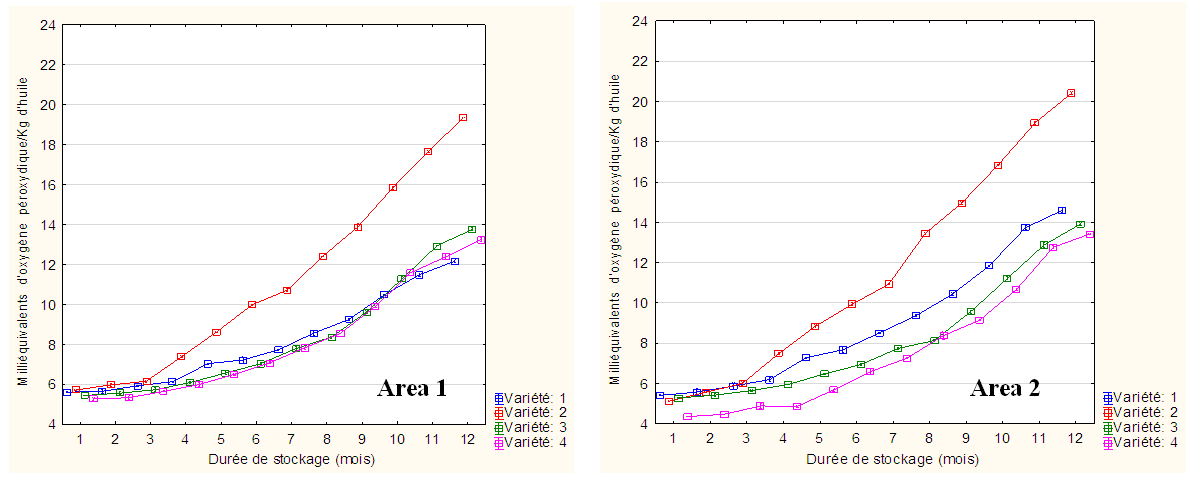 | Figure 5. Evolution of the peroxide value of olive oils (2011/2012) |
During the 2012/13 (Figure 6), all oils have evolved in two phases. The first presents with a small increase during the first 5 months, reaching values ranging between 5.40 and 8.10 Meq (O2)/kg and the second phase is characterized by a rapid increase to reach 20 Meq (O2)/kg for the oil of the Arbequina variety (limit standard 20 Meq (O2)/kg) after 12 months of storage in the dark at ambient conditions. The values of peroxide values of other oils Moroccan varieties (Moroccan Picholine, Haouzia and Menara) remain below the limit standard (20 Meq (O2)/kg), they range from 12.5 to 15.30 Meq (O2)/kg. Regarding the effect of the growing area, we observe that the oils produced in zone 1 is less intense peroxide as oil produced in area 2.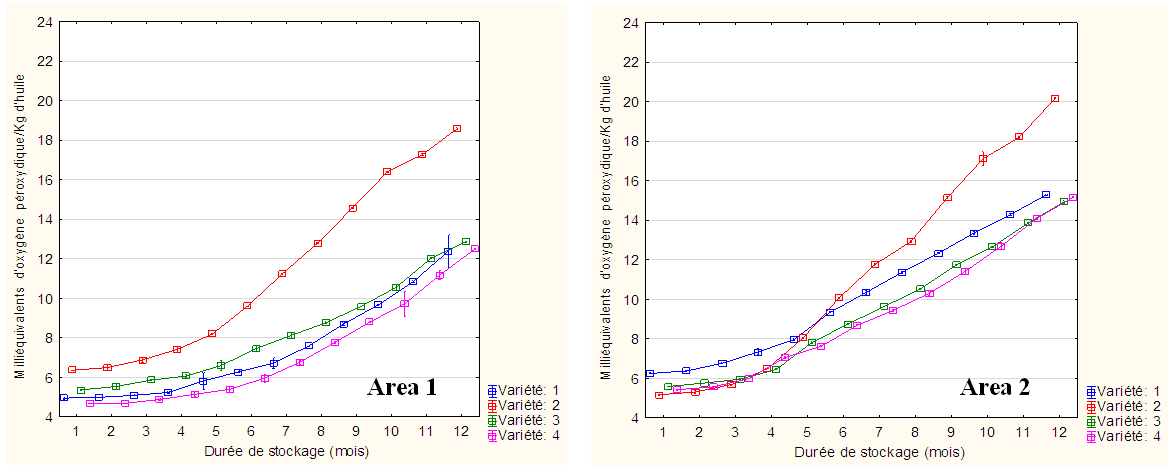 | Figure 6. Evolution of the peroxide value of olive oils (2012/2013) |
Evolution of the specific extinctions of olive oil during storageE270 absorptionThe secondary oxidation products hydroperoxides, especially diketones and unsaturated ketones, absorb light near to 270nm (E270) [20, 9, 19, 17]. More absorption at E270, the higher the oil is rich in secondary oxidation products [12]. The specific absorption is a picture of the oxidation state of oil.The initial values of absorbance at E270 (Figure 7, 8 and 9), remain very low. They vary between 0.07 and 0.10 depending on the variety, culture and countryside area. The maximum values were recorded in the oil of the Arbequina in both areas of culture, which explains the beginning of the formation of secondary oxidation products has already begun in the oil of the Arbequina.The results of the 2010/11 campaign illustrated in Figure 7, the evolution of secondary oxidation compounds, oils assessed by measuring the extinction coefficient at 270 nm (E270) experienced the same trend as the peroxide value. Indeed, after an initiation phase of a month, E270 rapidly evolving until the 12th month of storage. The accumulation of oxidation byproducts in the 12 months storage seems to support the idea of the balance between the formation and degradation of hydro-peroxides during the same period. Indeed, it was observed that the extinction E270 varies among the four studied oils with high extinction E270 in the Arbequina variety in area 1, and low in oils produced an area 2.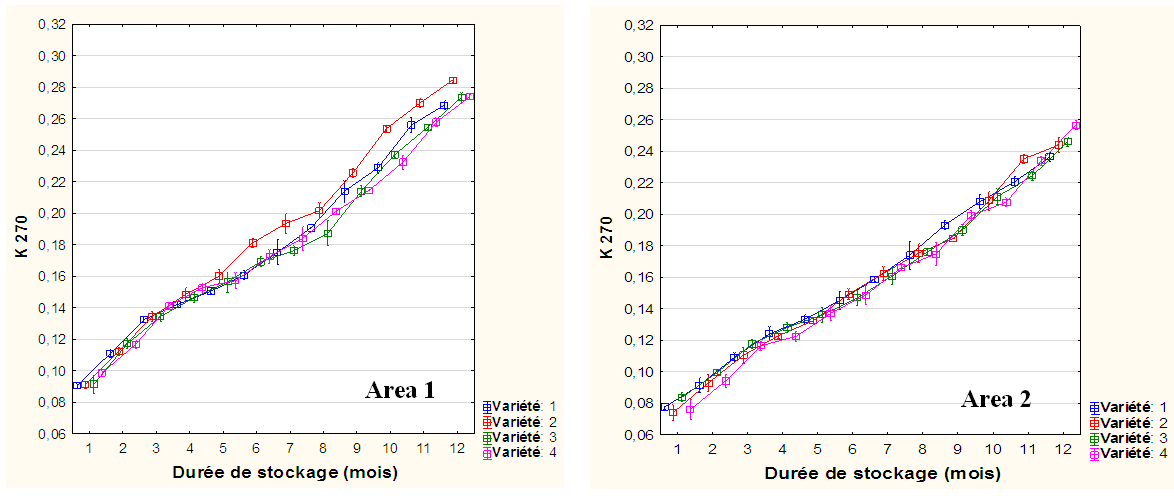 | Figure 7. Evolution of the extinction coefficients at 270 nm oils of four varieties studied (2010/11) |
Data from the 2011/12 season (Figure 8) show results that also coincide with the values of the peroxide value that tend to increase slightly throughout the storage period without reaching the final stage of oxidation of Olive oil (decomposition of hydro-peroxides). This oxidation resistance may be due to storage conditions (darkness) because the photo-oxidation mechanism is much faster than the auto-oxidation. After two months of storage, the secondary oxidation compounds predominate in oils stored light2. Point of view varietal, the results (Figure 8) shows that the specific extinction E270 in the oil of the Arbequina variety is high in both growing areas. The highest values are observed from the third month of storage. Regarding the growing area, the E270 extinction oils varieties of area 1 is lower than that of oils produced an area 2.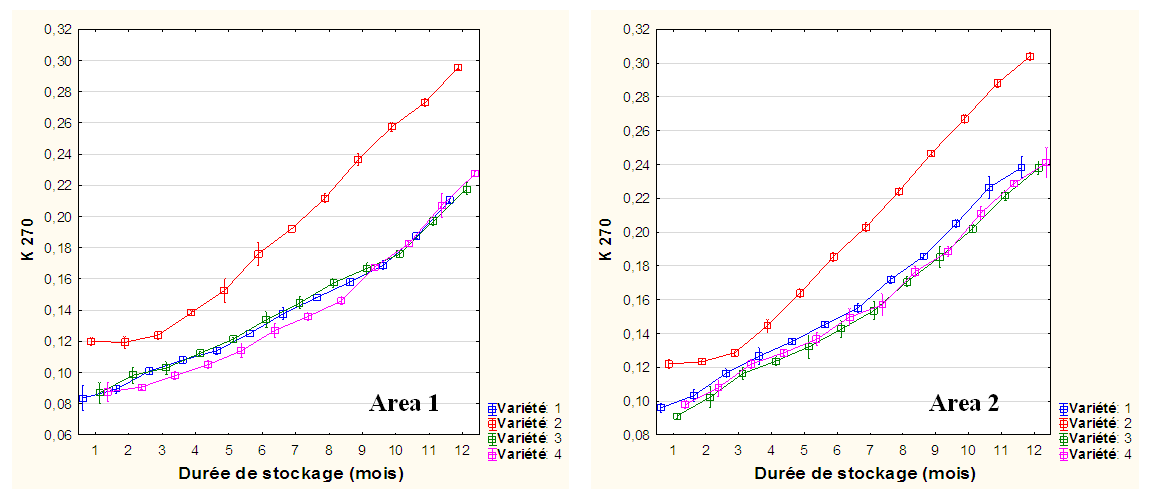 | Figure 8. Evolution of the extinction coefficients at 270 nm of olive oils of four varieties studied (2011/12) |
For samples tested during the 2012/13 campaign (Figure 9), the same trends as those of the peroxide value were recorded. These results are consistent with the work [1] on soybean oil and olive oil [10, 7]. From the results of Figure 9, the rate of oxidation by-products increased from 0.10 to 0.27 and 0.11 to 0.29 for the Arbequina oil and from 0.09 to 0 21 and 0.10 to 0.26 for oil, Moroccan picoline, of (between 0,10 and 0.26 and 0.08 to 0.20) for oil and Haouzia (0.10 to 0.22 and from 0.10 to 0.23) for oil Menara respectively in areas 1 and 2. The extinction E270 oil Arbequina the variety is always greater than that of the other oils tested. Point of view crop area, generally the E270 extinction oils varieties of area 1 are lower than that of the oil produced an area 2.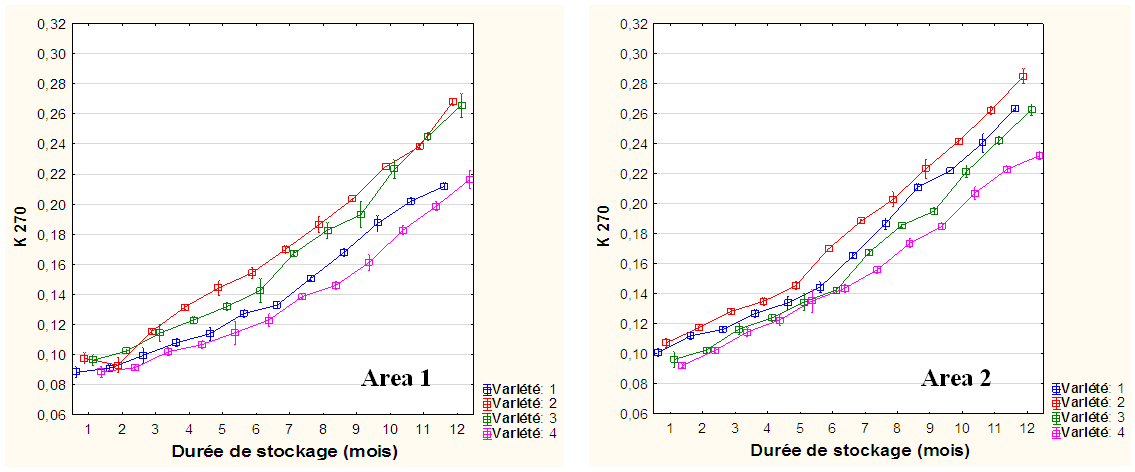 | Figure 9. Evolution of the extinction coefficients at 270 nm of olive oils of four varieties studied (2012/13) |
The light of these results, all oils have kept the name oil "extra virgin" after a year of storage in the dark at ambient conditions.E232b absorptionLinolenic hydroperoxides and oxidized fatty acids that are dienes, resulting from the decomposition of the peroxides have an absorption band near E232 nm [21, 18, 9].The absorbance of our E232 samples during the 2010/11 season evolves regularly with storage time (Figure 10). During the first 4 months of storage, E232 is slowly changing the 1st month (initiation phase) and then a more marked and rapid increase in values that vary in both areas between 2.45 to 2.60 for Oils Moroccan varieties. For the oil from the Spanish variety (Arbequina) The same trend was observed with higher values ranging from 2.73 to 2.87.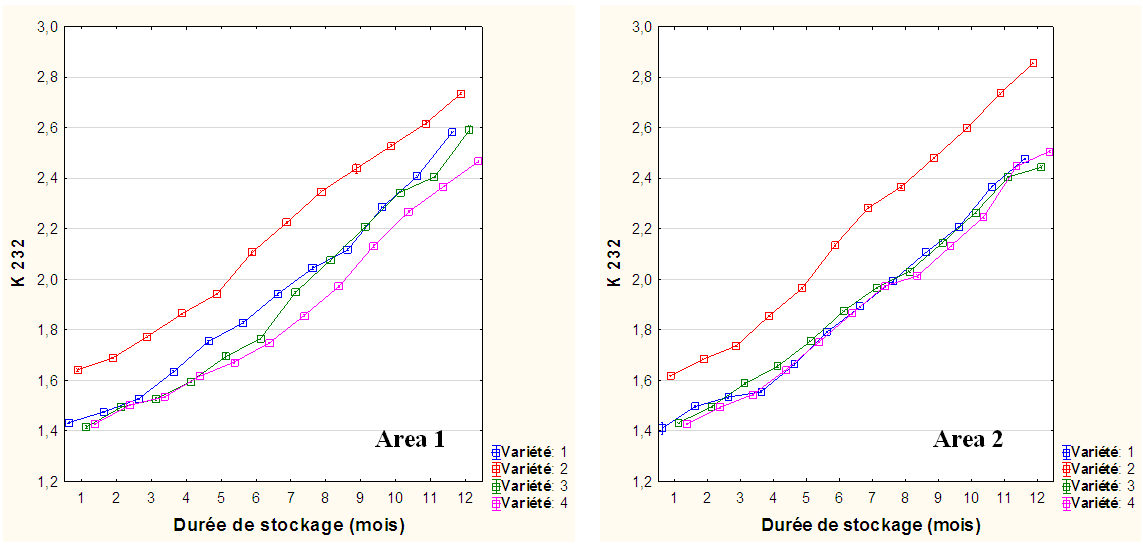 | Figure 10. Evolution of the extinction coefficients at 232 nm of olive oils of four varieties studied (2010/11) |
Point of view area, the results show no significant difference. However, maximum values for this indicator (E232) quality oils remain below the limit recommended for the oil "extra virgin" [4].The values in the 2011/12 season (Figure 11), changes in absorbance at 232 nm for all samples tend to increase, these vary among Moroccan oil varieties between 2.40 and 2.50 in the 12th months of storage. The highest values are recorded in the Moroccan Picholine variety. For the Spanish variety (Arbequina) values range between 2.59 and 2,67et they are recorded in area 2.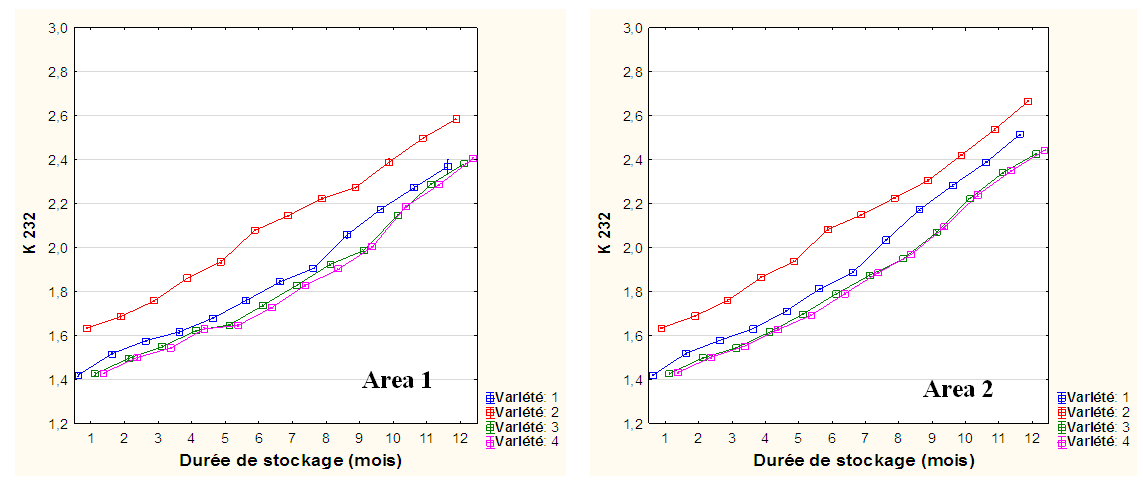 | Figure 11. Evolution of the extinction coefficients at 232 nm of olive oils of the four varieties studied (2011/12) |
During the 2012/2013 campaign and in the two study areas, Figure 12 shows that all oils have undergone an evolution content of hydroperoxides, but in different ways. Generally for all olive oils studied, an increase of 60 to 70% was observed. After a year of storage in the dark at ambient conditions, the E232 absorption increased from 1.42 to 2.5 for the oils of Moroccan varieties and 1.61 to 2.8 for oil of Arbequina.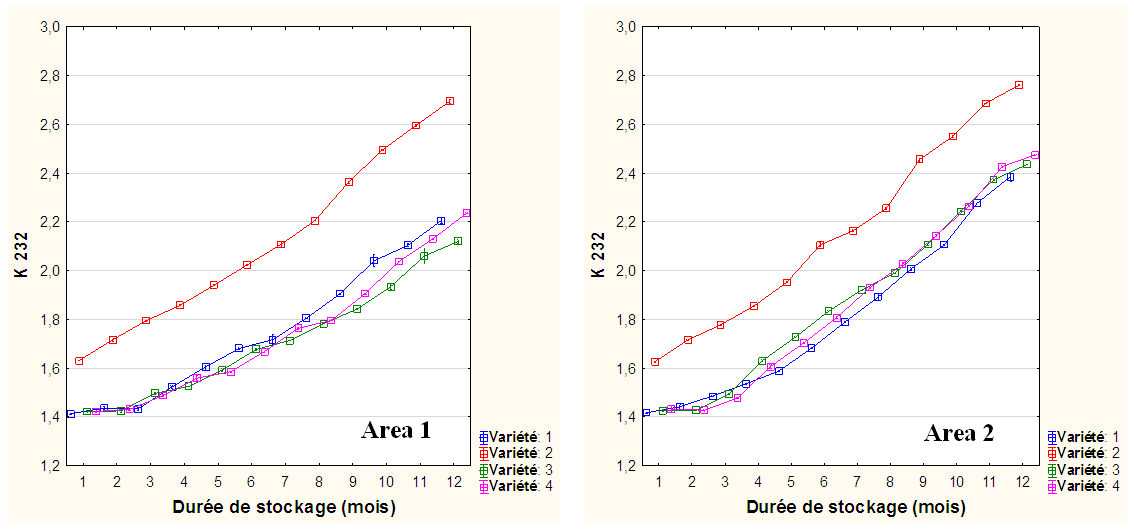 | Figure 12. Evolution of the extinction coefficients at 232 nm of olive oils of four varieties studied (2012/13) |
Point of view growing area, the results in Figure 12 show no significant difference in the oils of the four varieties studied.
4. Conclusions
In the dark, in ambient conditions the evolutions of the oxidative stability of four virgin olive oils were studied. The parameter of the oxidative stability of these oils varies from one season to another, depending on the variety and growing area. The study of the stability of oils extracted showed that the storage times and conditions have a significant influence on the quality of the oils. All quality parameters have shown different trends depending on the variety and growing areas.Examination of the results on the evolution of the acid value, peroxide value and E232 and E270 extinctions during storage for 12 months in the two areas and during three campaigns has shown that these physicochemical parameters become higher in oil from the Spanish variety (Arbequina). This suggests that the primary oxidation for this variety is faster than other varieties Moroccan (Moroccan Picholine, Haouzia and Menara), probably because of its sensitivity to oxygen.Perspective growing area, area 1 oils are more stable than the oils of the area 2.These four varieties studied have not lost labeling extra virgin olive oil after 12 months; they have maintained their quality extra-virgin oils in two storage areas.In general, olive must be kept in the dark oil, protected from light to prevent oxidation and degradation of oils. The container should be as opaque as possible. The contact with oxygen also degrades the quality of the oil. We must, therefore, ensure that the container that contains olive oil is as tight as possible.
References
| [1] | Anwar F., Chatha SAS and Hussain A. I., (2007). Assessment of oxidative deterioration of soybean oil at ambient and sunlight storage. Grasas Y Aceites. 58 (4): 390-395. |
| [2] | Caponio F., Bilancia M.T., Pasqualone A., Sikorsa E. and Gomes T., (2005). Influence of the exposure to light on extra virgin olive oil quality during storage. Eur. Food Res. Technol. 221:92-98. |
| [3] | Choe E. and Min D. B., (2006). Mechanisms and Factors for Edible Oil Oxidation. Food Sci. and Food Saf. 5 (4):169–186. |
| [4] | Codex alimentarius, (1989). Norme codex pour les huiles d’olive vierges et raffinées et pour l’huile de grignons d’olive raffinée. Codex STAN 33-1981/Rév. 1. |
| [5] | Conseil Oléicole International., (2009). Norme commerciale applicable à l’huile d’olive et à l’huile de grignons d’olive, 7-16. COI T. 15/NC n° 3/Rév. 4. |
| [6] | Crapiste G.H., Brevedan MIV and Carelli A. A., (1999). Oxidation of sunflower oil during storage. Jaocs. 76 (12): 1437–1443. |
| [7] | Dabbou S., Gharbi I., Dabbou S., Brahmi F., Nakbi A. and Hammami M., (2011). Impact of packaging material and storage time on olive oil quality. African J. of Biotech. 10(74):16937-16947. |
| [8] | Food Authenticity. 1998. Issues and Methodologies, F.A.I.M. Concerted Action, n° AIR3- CT94-2452. Eurofins Scientific. 214-257. |
| [9] | Grigoriadou K., Vasilakakis M. and Eleftheriou E.P., (2002). In vitro propagation of the Greek olive cultivar`Chondrolia Chalkidikis'. Plant Cell, Tissue and Organ Culture. 71:47-54. |
| [10] | Guil- Guil-Guerrero JL and Urda-Romacho J., (2009). Quality of extra virgin olive oil affected by several packaging variables. Grasas y Aceites. 60 (2):125-133. |
| [11] | Gutierrez F., Jimenez B., Ruiz A. and Albi M. A., 1999. Effect of olive ripeness on the oxidative stability of virgin olive oil extracted from the varieties picual and hojiblanca and on the different components involved. J. Agric. Food Chem. 47:121-127. |
| [12] | Gutierrez F and Fernandez J.L., (2002). Determinant parameters and components in the storage of virgin olive oil. Prediction of storage time beyond which the oils is no longer of «extra» quality. J. Agric. Food. Chem. 50:571-7. |
| [13] | Harwood J. and Aparicio R., (2000). Handbook of olive oil – Analysis and properties, An Aspen publication, Aspen Publishers, Inc. Gaithersburg, Maryland, 1-513. |
| [14] | Kondratowicz E.P. and Ostasz L., (2000). Quality changes in edible oils at high temperature kinetic analysis. Eur. J. Lipid. Sci. Technol. 276-281. |
| [15] | Poisson J.P. and Narce M., (2003). Corps gras alimentaires: aspects chimiques, biochimiques et nutritionnels. In Lipides et Corps Gras Alimentaires, Graille J (éd). Collection Sciences et Techniques Agroalimentaires, Editions Tec&Doc: Paris (France). 470p. |
| [16] | Ruir M.G., Plivillo M.M., Velasco J. and Dobarganes C., (2008). Formation of oxidation compounds in sunflower and olive oils under oxidative stability index conditions. Eur. J. Lipid. Sci. Technol.110:465-471. |
| [17] | Tanouti K, Serghini-Caid H, Chaieb E, Benali A, Harkous M and Elamrani A., (2011). Quality Improvement of Olive Oils Produced In The Eastern Morocco. les technologies de laboratoire. 6 (22): 1-12. |
| [18] | Tchiégang C, Ngo OM, Dandjouma AA et Kapseu C, (2004). Qualité et stabilité de l’huile extraite par pressage des amandes de Ricinodendron heudelotii (Bail.) Pierre ex Pax pendant la conservation à température ambiante. J. of Food Eng.62:69-77. |
| [19] | Vekiari SA, Papadopoulou P and Kiritsakis A., (2007). Effects of processing methods and commercial storage conditions on the extra virgin olive oil quality indexes. Grasas y Aceites. 58:237-242. |
| [20] | Vekiari S.A., Papadopouloua P. and Koutsaftakisb A., (2002). Comparison of different olive oil extraction systems and the effect of storage conditions on the quality of the virgin olive oil. Grasas y Aceites.53:324-329. |
| [21] | Wolff J.P., (1991). Analyse et dosage des lipides. In Techniques d’Analyse et de Contrôle dans les Industries Agro-alimentaires IV: Analyse des Constituants alimentaires, Multon JL (coordonnateur) (2ème edn). Lavoisier Tec et Doc: Paris (France).450p. |













 Abstract
Abstract Reference
Reference Full-Text PDF
Full-Text PDF Full-text HTML
Full-text HTML